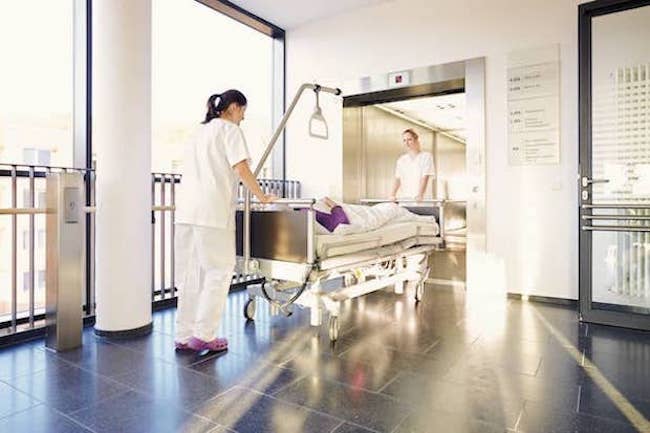
A patient lift is an essential tool at any medical facility or home care place. Also known as Hoyer lifts, patient lifts come with varying features, but all serve one purpose. They help with patient transfers. We present you here with a beginner’s guide to Hoyer lifts. We hope to help you understand how you as a caregiver can perform a patient transfer safely. Knowing how to use a Hoyer lift ensures your safety and that of your patients.
How to Use a Hoyer Lift
Learning how to use a Hoyer lift requires multiple steps. We’ve broken down every step below and included the necessary safety precautions that should be followed during each part of the process. Remember: the lifting process should be done slowly and carefully to avoid further injury or major discomfort.
1. Clear Space
The first step in using a Hoyer Lift is to ensure that the area is clear. Remove any clutter or other potential obstructions out of the way. These can cause the Hoyer lift to get caught or trip someone as they move. Once your space is completely clear, you can begin setting up the Hoyer lift.
2. Check Stability
As you begin to use the Hoyer lift the first thing you will want to do is ensure that it is stable. Hoyer lifts will have two legs that are parallel to the ground and are supported by four wheels. The wheels should be tightly attached and, in most cases, locked. This is to ensure the lift will not move as the patient is being lifted. Many models allow the legs to spread apart to further ensure stability.
3. Connect Boom
The long-angled bar at the top is called the boom. This piece holds the swivel bar to which the sling can be attached. The boom is moved up and down with either manual or electric power. You want to be sure that the swivel bar is connected correctly before use. Additionally, make sure that the sling is well hooked before setting the patient onto it.
4. Know Your Sling
Knowing how to use a Hoyer lift means understanding the type of slings that are used on it. Each sling has a specific kind of function to it, some are more comfortable than others, but all serve the same purpose.
Universal slings, or U-slings, are most common, and their name comes from their “U” shape. The “U” is formed by two long extensions that run parallel to each other. The padding on the sling makes it one of the more comfortable sling options around. The U-sling is the premier option at most medical facilities.
Full body slings and standing slings are slightly less common but may be beneficial. Full body slings offer more advanced back and head support. Standing slings, on the other hand, are a great option for those who still have partial mobility but may need additional neck and head support.
5. Check for Defects
Before placing a patient onto the sling, you want to be sure that it is free of any holes or rips. Slings are typically well-made but do require inspection; the safety of your patients is vital, after all. Once you have correctly checked the sling, you can attach it to the hooks on the swivel bar.
6. Begin Lifting
Depending on the type of Hoyer lift you’ve chosen, this step may vary. Ensure you know how to use your chosen Hoyer lift before lifting.
Manual Lifting
Manual lifting requires that you find the valve at the base of a manual lift’s pump handle. If the valve is facing the pump handle, the lid is closed. When the valve is facing away from the pump, the boom can be lowered or raised. The movement from open to close should be performed gently. Practice reducing and boosting the boom before ever putting a patient on the sling.
Electric Power Lifting
Electric lifts do a lot of the work for you, but that does not mean that you can just stand back. You need to know where critical parts should be, such as the emergency release control, in case of power outages. Emergency release controls lower the patient when the power goes out, and some machines may have more than one. Know where to find these in case of an emergency.
7. Complete Transfer
The final Hoyer lift transfer should be done once you have checked off everything else on this guide. Lastly, check the maximum weight the lift can comfortably handle before setting the patient on it. Transferring the patient and how it is performed is dependent on the condition of said patient and the location of the transfer. Moving your patient from a bed to a chair or vice versa will require different movements and methods for placement.
8. Lower Patient
Carefully lower your patient to their intended location. Depending on where you are placing them, you’ll need to lower them using specific methods.
Chair
If you are transferring your patient into a chair, ensure that they are placed as far back as possible for maximum comfort. Allow their back to slide along the back of the chair as you lower. It may help to tip the chair just slightly to avoid getting the lift caught on the chair. Gently push on your patient’s knees as you lower them so they are properly seated. Once your patient is placed, remove the sling by pulling slowly upwards. Avoid pulling too hard as you don’t want to cause discomfort.
Bed
The bed should be leveled with the sling before the patient is moved onto it. Start by guiding the patient until they are fully over the bed. Lower the bottom of the sling first before lowering the back support. Slowly turn your patient onto one side to remove the sling from underneath them. Place your patient back into a lying position and return the sling to your lift. This entire process should be done slowly to avoid injury or discomfort.
For a more visual representation of how to use a Hoyer lift, please reference the video below.
Recommended Hoyer Lifts
There are plenty of quality Hoyer lifts available for at-home use. We’ve highlighted just a few below. When preparing to rent or buy a Hoyer lift, be sure to check if your Medicare plan will cover the lift.
1) Hoyer Professional Advance-E Portable Electric Patient Lift
The Hoyer Advance-E is compact, yet able to perform an outstanding range of transfers. Whether from the floor or onto a healthcare bed, the Advance-E Electric Lift copes with ease. The Advance E's unique tapered leg design allows the lift to get even closer to the widest of obstacles. This is especially useful when encountering large chairs, bulky commodes, and wheelchairs. The tapered design also ensures that the resident feels safe and secure during the transfer. The Advance-E Patient Lift is compact, yet able to perform an outstanding range of transfers.
2) Hoyer Presence Professional Electric Patient Lift
The Hoyer Presence patient lift is engineered and designed to handle almost any resident-handling task. With its outstanding lift range, the Presence can accommodate lifts from the floor, as well as transfers to higher surfaces. The hand control clip holds the pendant in place when it is not being used, preventing it from falling and possible damage The base, for example, has an ergonomic footpad design allowing the caregivers to better control lift movement. The base is also controlled by two electric actuators which allow the caregiver to open and close the base with bending or twisting.
3) Hoyer Calibre Professional Series Electric Patient Lift
The Hoyer Calibre is a uniquely designed electronically operated patient lift for the safe lifting of heavier patients. It is both sturdy and robust with a safe working load rating of 850 lbs. The Calibre has been designed to be configured with or without a weigh scale. The weigh scale is seamlessly integrated with a digital display on both sides and user-friendly controls. The large, open cradle results in less discomfort to the patient caused by pinching and squeezing.
4) Hoyer Hydraulic Lifter Manual Patient Lift
The Hoyer Hydraulic Patient Lifter has a heavy-duty steel base. This model is a step above the basic Hoyer Classic lift and other patient lifters. Locking casters come standard and facilitate secure and safe transfers to and from the commode, chair, or bed. This Hoyer lift is able to pick the patient up from the floor and the hydraulic pump handle allows operation from either side of the lift. The cradle is designed to handle 4-point and 6-point slings. The adjustable base spreads easily with a hand lever to increase stability during patient transfers. With the legs closed, you can easily fit through most doorways.
5) Hoyer Advance-H Portable Manual Patient Lift
The Advance is compact, yet able to perform an outstanding range of transfers. Whether from the floor or onto a healthcare bed, the Advance copes with ease. The Advance's unique tapered leg design allows the lift to get even closer to the widest of obstacles. This is especially useful when encountering large chairs, bulky commodes, and wheelchairs. The tapered design also ensures that the resident feels safe and secure during the transfer.
Amica Hoyer Lifts
Amica Medical Supply is a leading online Authorized Dealer of popular Hoyer lift brands. With access to a multitude of manufacturers, Amica is able to offer all the products you need with the added bonus of special deals and savings. Shop our array of Hoyer lifts, both manual and electric, and other medical devices that you won’t find anywhere else.
To learn more about how to use your Hoyer lift or find a Medicare-approved lift, call Amica at 1-888-939-0774!



